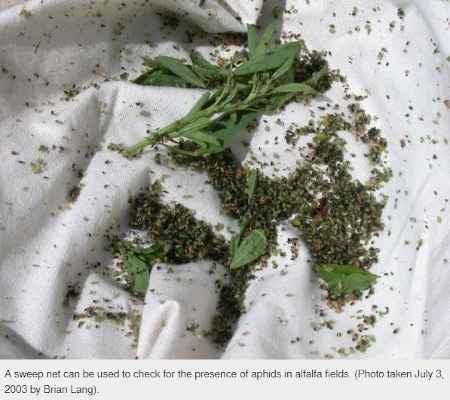By Rebecca Vittetoe and Brian Lang et.al
Alfalfa weevils aren’t the only insect pest being found in alfalfa fields this spring. Reports of aphids, particularly cowpea aphids and pea aphids, have been made around the state. This article will discuss identifying the common aphid species found in Iowa as well as scouting and management recommendations for aphids in alfalfa.
Aphid species
In general, aphids are soft bodied and pear-shaped insects. They have a piercing-sucking stylet (mouthpart) and feed on sap within the plant phloem. The two cornicles, which are like tailpipes, on the tip of the abdomen is an important diagnostic feature to distinguish aphid species. Table 1 lists the four common aphid species found in Iowa. Additional information on these different species can be found online.
Table 1. Common alfalfa aphid species found in Iowa.
Aphid species
(common name) | Size and color description | Population peak |
Blue alfalfa aphid | 3/16”; blue with black cornicles | March – June |
Cowpea aphid | 1/8”; shiny black with black cornicles | April |
Pea aphid | ¼”; pale green or pink with dark cornicles | April – November |
Spotted alfalfa aphid | 1/8”; pale yellow with dark spots on abdomen and short cornicles | May – October |
Aphid scouting, thresholds, and management
The good news is harvesting alfalfa is an excellent method to control aphids as very few aphids will survive. Many fields have already been harvested or will soon be harvested. Additionally, natural enemies, like ladybeetles or damsel bugs, can help keep aphid populations in check. As the alfalfa starts to regrow below are guidelines on how to scout and monitor fields for aphid pressure.
To scout for aphids, count the number of aphids on at least 30 alfalfa plant stems. Average the number of aphids per stem. Since populations can be spotty across fields, it is recommended to sample multiple areas across the field when doing the stem counts. The economic thresholds for aphids are summarized in Table 2.
Table 2. Economic thresholds for pea aphids, blue aphids, cowpea aphids, and spotted alfalfa aphids. (Source: IPM-58).
Plant Height | Pea aphids/stem | Blue aphids and Cowpea aphids/stem | Spotted alfalfa aphids/stem |
< 10” | 30-50 | 10-50 | 10-20 |
10-20” | 50-75 | 30-50 | 20-40 |
>20” | 100 | >50 | >40 |
Spraying before the economic threshold is met can lead to an aphid resurgence. Only spray once the threshold is reached and if the field is not ready to be harvested. If an insecticide is warranted, always read and follow the label instructions. Pay attention to pre-harvest interval when spraying, and make sure to use sufficient volume and pressure when spraying to ensure contact with aphids on the lower parts of the plants.

Source : iastate.edu